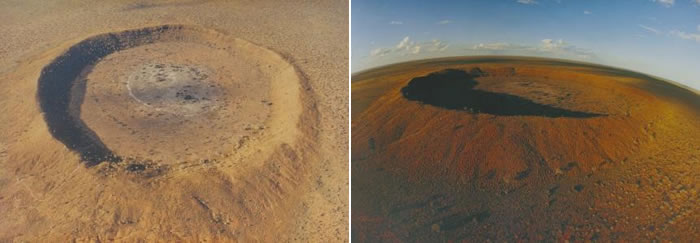Wolfe Creek Crater |

Wolfe Creek Crater is a meteorite impact crater, 880m across located in the north east tip of Western Australia.
The Wolfe Creek crater is the second largest crater in the world after the Barringer Crater in Arizona.
The crater is central to the Wolfe Creek Meteorite Crater National Park
Crater creator
The Wolfe Creek meteorite crater was only discovered by Europeans during an aerial survey in 1947.
The meteorite crashed to Earth around 300,000 years ago. It would have weighed more than 50,000 tonnes and is thought to have been travelling at 15km a second, a speed that would have taken it across Australia in five minutes.
Aboriginal significance
The local Djaru (Jaru) Aboriginal people refer to the crater as Kandimalal. There are multiple Dreaming stories about the formation of the crater. One such story describes the crater's round shape being formed by the passage of a rainbow snake out of the earth, while another snake formed the nearby Sturt Creek.
Another story, as told by an Elder, is that one day the crescent moon and the evening star passed very close to each other.
The evening star became so hot that it fell to the ground, causing an enormous explosion and flash, followed by a dust cloud. This frightened the people and a long time passed before they ventured near the crater to see what had happened. When they finally went there, they realised that this was the site where the evening star had fallen to the Earth. The Djaru people named the place "Kandimalal" and it is prominent in art from the region.
Enjoying the park
Sightseeing, walking, photography and nature observation are the most popular activities. Viewing the crater rim is a must. Another spectacular way to view the crater is to take an aerial flight from Halls Creek. A camping area in the national park is free to visitors and includes cleared sites and toilets.
Crater climb
A 400m return walk to the top of the crater rim involves a steep rocky climb. Climbing down into the crater is not permitted because the steep terrain and loose rocks make it dangerous.
Video: Earth from Space
Know before you go
The best time to visit the park is from May to October, when the weather is fine and temperatures are moderate. The park is generally only accessible to conventional vehicles during the dry season. No water is available so please bring ample supplies with you. Leave rocks and cultural artefacts as you find them. No bins are provided so please take your rubbish with you.
Getting there
The turnoff to the Wolfe Creek Crater National Park is situated approximately 154 kilometres south of Halls Creek along the Tanami Road. From the turnoff, it is approximately 23 kilometres to the carpark.
When travelling to Wolfe Creek be prepared for unsealed roads and always close access gates when travelling on the access road. It is always recommended to travel in a 4WD vehicle due to the corrugations. Contact Halls Creek Travel & Tourism for up to date road conditions before travelling.
Facilities: There is a DPAW campsite with basic toilets, however you need to be totally self-sufficient for all your supplies. Please note there is no water available.
Road access may be closed during the wet season (usually October to April).
We recognise and acknowledge Aboriginal people as the traditional custodians of Wolfe Creek Crater National Park.
Tours
Tour companies
Where to stay in Halls Creek
Halls Creek accommodation includes Halls Creek Motel (4 stars) and Kimberley Hotel (3.5 stars)
Agoda
The closest town to Halls Creek is Fitzroy Crossing, 290km to the west. Domestic flights from Perth to Broome and Kununurra depart year round, and direct flights from Sydney and Melbourne to Broome are available during the summer months.
❊ Address ❊
⊜ Tanami Road Wolfe Creek View Map
✆ Telephone: Halls Creek Visitor Centre: 08 9168 6262
❊ More Information ❊
→
parks.dpaw.wa.gov.au
➼ www.balgoart.org.au
➼ www.wikipedia.org
➼ dpaw.wa.gov.au
➼ www.australiasnorthwest.com
➼ www.westernaustralia.com
➼ www.hallscreektourism.com.au
Update Page








